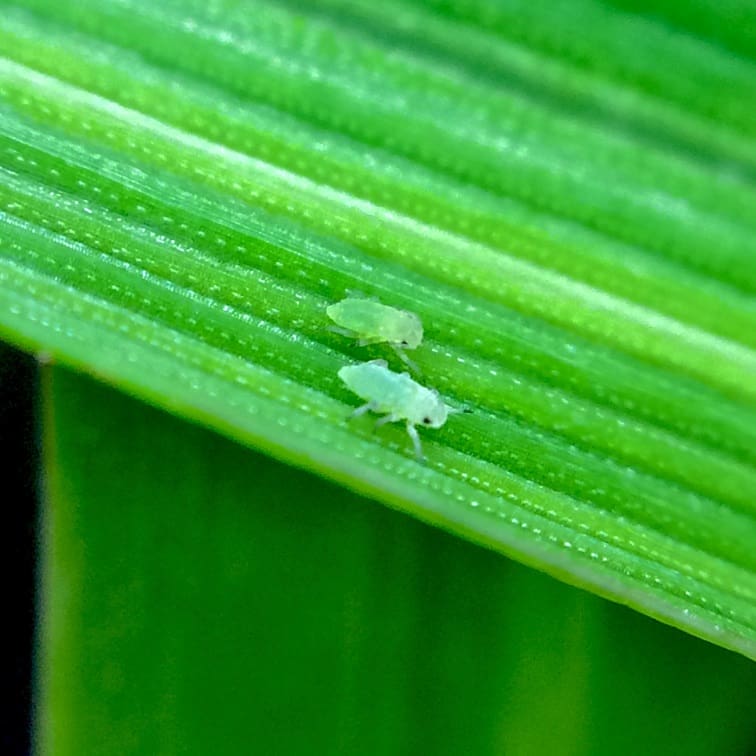
While RWA is a high priority pest, it is manageable and the best thing growers and advisers can do is regularly monitor crops for signs of infestation. (Photo GRDC)
QUEENSLAND grain growers and their advisers have been advised to ‘be alert, not alarmed’ by the probability that Russian wheat aphid (RWA) will be found in the State’s cereal crops this season.
Speaking at a RWA information session in Toowoomba, South Australian Research and Development Institute (SARDI) research entomologist Maarten van Helden said it was inevitable Australia’s latest broadacre crop pest would soon be found in the State.
RWA was first detected in Australia in 2016 and is now present in cropping areas of South Australia, Victoria, Tasmania and southern New South Wales.

South Australian Research and Development Institute research entomologist Maarten van Helden said it was almost inevitable Russian wheat aphid would soon be found in Queensland. (Photo: GRDC)
“Last year, RWA was confirmed on the Liverpool Plains in northern NSW and we believe it will continue to spread into the cereal growing regions of Queensland,” Dr van Helden said.
“While RWA is a high priority pest, it is manageable and the best thing growers and advisers can do is regularly monitor crops for signs of the pest.
“There are very distinct plant symptoms associated with RWA and early detection will give growers time to make informed, timely, cost-effective decisions about the appropriate management strategy for their situation.”
Despite collecting more than 120 samples from roadsides and farms in Queensland and northern NSW as part of the current survey, Dr van Helden said RWA had yet to be found.
“This survey included the key cereal growing regions in the northern region, so the Liverpool Plains, Tamworth, Narrabri, Moree, North Star, Garah, Boomi, Goondiwindi, Brookstead, Bongeen, Toowoomba and Dalby,” he said.
“We collected samples in Queensland from 10 sites and failed to detect any RWA.
“But growers and advisers need to remain vigilant and monitor paddocks regularly, because we are positive these pests will arrive in Queensland and early detection will give growers time to determine the appropriate action for specific crops.”
Dr van Helden recommends growers and advisers follow the FITE (find, identify, threshold approach and enact) strategy which has been developed as a simple guide to RWA management. It involves:
- Find – Look for aphids and the characteristic plant symptoms of infection including leaf streaking or leaf rolling on cereal crops and grasses;
- Identify – Positively identify RWA by consulting with an industry specialist;
- Threshold approach – Before deciding on your plan of attack consider thresholds for control, the presence of natural aphid enemies in the crop, crop growth stage and potential yield losses;
- Enact – Take appropriate action: Manage your next steps including encouraging beneficial insects and protecting honeybees before implementing control options.
Weeds and volunteer cereals harbouring aphids may not necessarily show symptoms of infestation, so growers are advised to closely inspect grasses by unfurling leaves and checking inside partially emerged heads, paying particular attention to annual weedy barley grass.
Seed treatments
Dr van Helden said neonicotinoid seed treatments might provide effective early season control of RWA. Preliminary evidence indicated the length of protection was expected to be equivalent to that observed for other cereal aphid species.
However, prophylactic use of neonicotinoid seed treatments is discouraged and should be targeted at those situations deemed to be of higher risk (early sowing, especially early sown barley crops; or areas where volunteer cereals and/or live aphids are identified prior to sowing).
Crop monitoring
Dr van Helden said crops should be monitored regularly throughout the season.
- Crops can be infested under warmer conditions in autumn, during the early stages of establishment, from wingless aphids walking off nearby senescing hosts.
- Intensive monitoring of early-sown crops, including cereals sown as pasture, should occur for the first 4-8 weeks after sowing.
- Populations frequently start to increase as temperatures warm in spring or typically from tillering onwards.
- Stressed areas of the paddock are often the first to be infested and hence monitoring may specifically target these areas first.
Management
“Growers are advised to adopt a threshold-based management strategy. Chemical control is warranted if infestations exceed thresholds of 20 per cent of seedlings infested up to the start of tillering and 10 per cent of tillers infested thereafter,” Dr van Helden said.
“Yield loss may be minimised through protection of the top three (major yield contributing) leaves. Current research investments by the GRDC will allow us to be develop more regionally specific thresholds as our understanding of potential RWA impact on regional production improves.”
He said growers should be reassured that the summer growing cereals were not under threat from the pest.
He said growers and advisers should consider the following measures:
- If spraying is warranted, use softer chemistry (e.g. pirimicarb) where possible to encourage natural predators and beneficial insects, especially early in the season.
- Avoid prophylactic insecticide applications.
- If infestation warrants chemical control growers and advisers should refer to the Australian Pesticides and Veterinary Medicines Authority (APVMA) website for the most recent products under registration or permit. Good spray coverage and consideration of weather conditions (temperature, rainfall) in the 24 hours prior and shortly after chemical application are important.
Source: GRDC
For information on RWA management go to the Tactics for Future Control publication, available at https://grdc.com.au/rwa-tacticsfuturecontrol as well as I SPY, a comprehensive crop insect identification manual, which can be viewed at https://grdc.com.au/I-SPY.
GRDC also has an online RWA resource with key information for growers and advisors at https://grdc.com.au/russian-wheat-aphid
Growers and advisers are encouraged to report occurrences of RWA to the Exotic Plant Pest Hotline on 1800 084 881. These reports will aid in improving understanding of RWA range and rate of spread.
For formal identification of RWA, Queensland growers and advisers can send samples to Melina Miles, DAF, PO Box 2282, Toowoomba, Queensland. For more details about sample collection contact [email protected].
In northern NSW samples can be sent to entomologist Zorica Duric, NSW DPI, Tamworth Agricultural Institute, 4 Marsden Park Road, Calala, New South Wales 2340. For more details about sample collection contact [email protected].



HAVE YOUR SAY